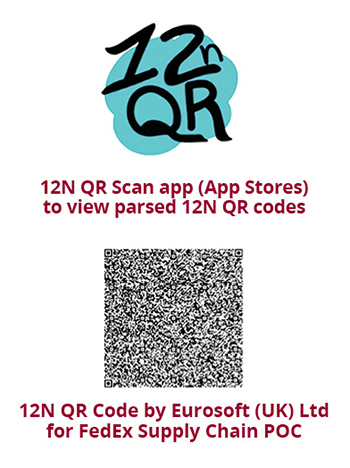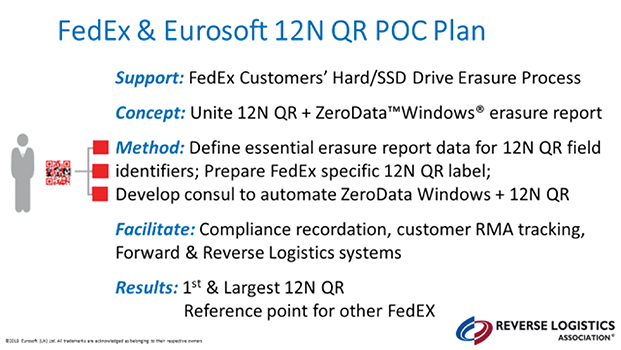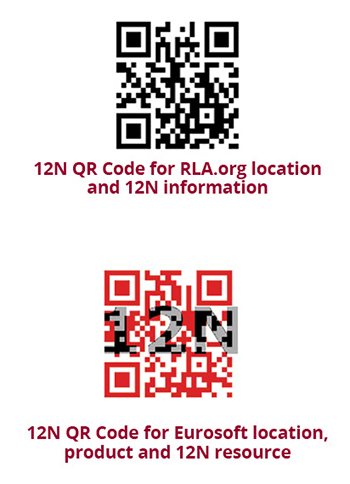FedEx proves ZeroData Windows data erasure inside the latest 12N QR Code
By Sharon Richards, Eurosoft (UK) Ltd
When data erasure became a matter of how to securely track critical compliance reports, all contained within a tiny QR code, who else to accept the challenge – none other than FedEx Supply Chain of course. The proof of such an idea came to realization at the recent 2019 Reverse Logistic Association (RLA.org) Expo in Amsterdam. Presenting this big idea to an attentive and discerning gathering of OEMs and service organisations, played out as a fast roll of topical points and sound-bites of information in about 30 minutes. Hence, more details from Eurosoft (UK) Ltd follow here.
As a call to action, the RLA.org were seeking new ways and means to get active participants using their 12N QR code standard. Finding formative resources (aka users) to enable and demonstrate the many capabilities of the 12N QR code was needed. Those means, providing one example to prove the 12N QR code usefulness, was recently established with collective efforts from two ambitious, specialist software developers, Eurosoft (UK) Ltd located in Bournemouth, England, and InforMission from Fremont, California. Together with the FedEx Supply Chain test lab in Tennessee, ideas were teamed, setting out a new methodology to organize data erasure processing, integrating the 12N QR code with Eurosoft’s ZeroData Windows software, a very fast and versatile storage device data erasure tool FedEx Supply Chain use to support refurbishing operations.

Getting to grips with data erasure is a feat unto itself. There are a wide variety of international compliances to be considered, with essential certified data erasure reports to be prepared and delivered across the supply chain. From cradle to grave, the correct, secure erasure of storage devices, collection and recordation of each erasure method, requires a clear process and substantial erasure tools to ensure reliability. Software applications such as ZeroData Windows lead the data erasure pack of practices. Combined with FedEx Supply Chain’s stringent storage device erasure protocols, and superior customer-care-of-duty, developments were soon underway. Eurosoft connected with the RLA.org 12N project leader, InforMission, to develop a clear path for pushing the 12N QR code to its next great achievement – proving the largest amount of data held yet in the 12N QR code container. Another first, and a massive advantage in the potential for data distribution, scan-able from only a mobile phone.
The aim of this co-sponsored development was to demonstrate how FedEx utilise the 12N QR code and 12N QR Scan (in App Stores) during its secure data erasure services performed on a variety of its corporate customers’ storage devices with the ZeroData Windows program.
The FedEx criteria and plan was called out as follows:
Why…because they…
- refurbish millions of PCs yearly, and they use ZeroData Windows to erase loads of storage devices and drives of various sizes, types and brands. Not just a palsy “79% of drives tested… out of a survey of 30”, sample.
- have a dedicated engineering team to critically evaluate and understand the depths of all kinds of PCs drive types.
- understand refurbishing and compliance implications.
Proof of Concept (POC) Plan…
This following slide was presented at the Amsterdam event portraying the planning steps taken to where the 12N is at now. It’s still growing as this is being written.
Understanding where 12N aspired and its capability requires a bit of background. The short version starts with the concept of the 12N standard. Originally created by the RLA.org and InforMission nearly 7 years ago, then known as the “SqrL” code, their idea in earnest was to propagate a new, internationally acclaimed, standardised data format, allowing wider adoption of their 12N QR code version across organisations and businesses, both private and public sector. The aim: to dynamically share relevant information across supply chains, whether governmental or consumers alike – without time consuming replication of effort.

12N is cleverly abbreviated for the extensive accreditation it has gained: MH10 12N Data Identifier approved by both American National Standards Institute as ANSI MH10.8.2 and ISO 15434 International Standards Organization for encoding information on global packaging. 12N was awarded its full recognition for international use after years of tedious documenting to obtain the necessary levels of authorization for standards encoding information on global packaging.
Standards bring purpose. Paraphrasing earlier accountings, 12N is a labelling information standard with all kinds of structure as you’d expect of a standard. The 12N standard itself conforms to RFID, barcodes and QR codes allowing companies to build on their existing data. The 12N QR code takes several leaps further, accelerating data to fill a higher capacity format that the base 12N standard provides. 12N codes are not here to replace existing bar coding systems, or other applications of QR codes – it supplements existing labels as QR containers. Its purpose is to minimise duplication of effort, reducing replication or possibly even the expansion of too much information.
What about the 12N QR code capability? Well, this big QR code container is evolving to hold over 4000 characters of detailed information versus a comparable 500 characters typically found in a bar code. This means users of the 12N QR can deliver 8-times more information than previous QR codes, scan-able using as little as a mobile phone, depending on the data size. Think… a condensed way to present [whatever] information is useful to front-line service personnel and consumers…details such as documentation, directions, contact phones, specifications, recycling data, Internet links and emergency information to name a few. The big difference with QR codes versus barcodes is that barcodes are quite static – once printed, they are not updatable. Globally, they both share information on product packaging – we’re all familiar with these with many of us having used the UPC code for such things as a product rebates. 12N QR codes however – are dynamic and updatable. Once a 12N QR label is fixed on a product or service, it can be updated with new information simply by stating that instruction in the original QR code for future review, or simply update with a new label. Technical highlights of the 12N standard includes a supported framework with versatile 12N Field Identifiers (FI), allowing users of the 12N protocol to build on existing data formats, saving time and resource. It functions as an XML Tag and converts data with JSON formats for Cloud enablement to engage global interaction.
ZeroData Windows capability as a portable or industrial-configured data erasure software solution, conforms its tamper-proof, certified report to the Field Identifiers designated by the 12N QR code standard. Substantial amounts of erasure data from as many as 99 drives per system on data storage such as NVMe, SSD, ATA, RAID and others, supporting 22 international data erasure compliances are presentable within the 12N QR code container. The combined international agility and flexible data fields of these two programs gives FedEx Supply Chain, and potentially others seeking secure and distributable data erasure reporting, a new idea for processing storage devices using 12N for PCs.

The future of the 12N schema has grown since its inception and will continue to be modified as new ideas are accepted. Possible revisions to the standard may lead to changes just as Eurosoft (UK) Ltd and FedEx Supply Chains’ requirement did for expanded Field Identifiers. During the Amsterdam presentation, noteworthy input from Cisco suggested activating the ZeroData Windows data erasure via the 12N QR code – plausible with the ability to include about 600 words of clear instructions. New 12N QR label versions for maintaining backward compatibility is another reverse logistic consideration, ensuring older consumer products have clear information for replacement, updating or recycling, starting from the OEM point. BOSE, another Amsterdam attendee, with an outstanding track record of quality products, could dynamically notify its customer base of new products or incentives simply by scanning the 12N QR code whether on the package or as a computer aided image. Compliance officiators such as R2, could enable international distribution summaries of their refurbishing chain criteria. The mind boggles with ideas.
Finally, securing the co-sponsoring assistance for a POC from a prestigious organisation such as FedEx Supply Chain is helping other organisations to envision how they can adopt the 12N standard for their particular requirements. As a recognised and supported framework, with versatility to fit specific organizational and business needs, Eurosoft (UK) Ltd is excited about the 12N possibilities for its other Pc-Check products, and the thousands of other industry and organisational sectors globally.
Interest in adopting the 12N QR code standard or purchasing the 12N code converter, check out the RLA.org website under the Standards menu. In the meantime, go to your App Store or GooglePlay and download the ‘12N QR’ – no other will give you the detail 12N can.
 Sharon Richards
Sharon RichardsSharon Richards holds directorships at Eurosoft (UK) Ltd. and its US operation, Eurosoft US Inc. Now in its 39th year, the Eurosoft team develop the innovative Pc-Check® diagnostic suite and ZeroData™
Windows® data erasure software solutions to maintain system hardware reliability, and sustainability. Sharon’s role ensures the team meet progressive testing needs within the value-chains of computer manufacturers and integrators, retail and public services, as well as the follow-on industries of computer repair, refurbishment and recycling. Priorities are creating frameworks that connect customers with test processes and tools, applying 30+ years’ experience gained in the global PC market. Active in the RLA.org Standards committee, promoting the wider use of the 12N QR Code for logistics tracking.
Sharon holds a masters in Marketing and Business from Nottingham Trent University, participates with Rotary International and continues to reside in the United Kingdom. Allegory: Take time to consider outcomes, plan for the past – reverse logistics happen.